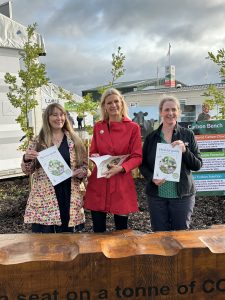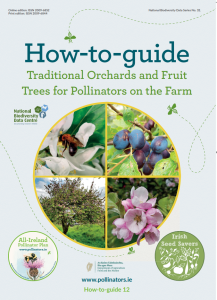The All-Ireland Pollinator Plan were delighted that Pippa Hackett, the Minister of State for Land Use and Biodiversity, in the Department of Agriculture, launched our latest new free resource, at the National Ploughing Championship.

The How-To-Guide: Traditional Orchards and Fruit Trees for Pollinators on the Farm was produced in collaboration with Irish Seed Savers.
Orchards and fruit trees on the farm
The guide was developed in collaboration with Elaine Bradley and Gillian Lattimore of Irish Seed Savers.
Small orchards have in the past been a feature of many farms across the island of Ireland, providing traditional varieties of apples, pears, plums and damsons. The crop was sometimes destined for local sale or for use in the home.
The Department for Agriculture, Food and the Marine (DAFM) has included ‘Planting a Traditional Orchard’ in the recent ACRES scheme, to support biodiversity and help ensure the survival of traditional Irish apple varieties.
This guide will help farmers to create and manage traditional orchards and fruit trees for pollinators on the farm, garden or other areas of land.
It will help you to choose the right planting site, variety, and tree type. There’s such an array of traditional varieties to choose from. DNA analysis and finger printing work by Irish Seed Savers has confirmed 200 different varieties, each with their own history dating back as far as 500 years.
They include:
Cooking apples – the Ballyvaughan seedling, the Leitrim Red and the Cavan Strawberry.
Eating apples – Kilkenny Pearmain and Irish Peach
Crab and Jelly apple from Roscommon – the Lough Key Crab
Why is pollination important?
In the guide you’ll find tips on how to encourage pollinators to your orchard, as cross pollination with another fruit tree is essential to ensure a good crop. Also, how to maintain both your new orchard and an existing orchard.
FREE natural pest control!
You’ll find out what pollinators you can expect to see in your orchard and which natural predators to encourage, as they can help prevent damage to the crop, by managing pests.
This guide builds on the resources available to farmers, businesses, community groups and gardeners that you can find at www.pollinators.ie

